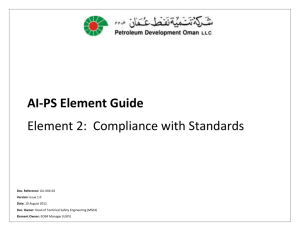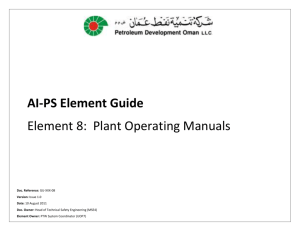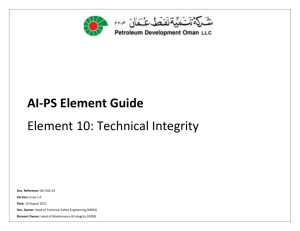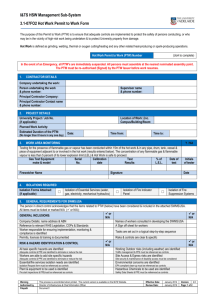AI-PS Element Guide: Permit to Work (PTW) System
advertisement
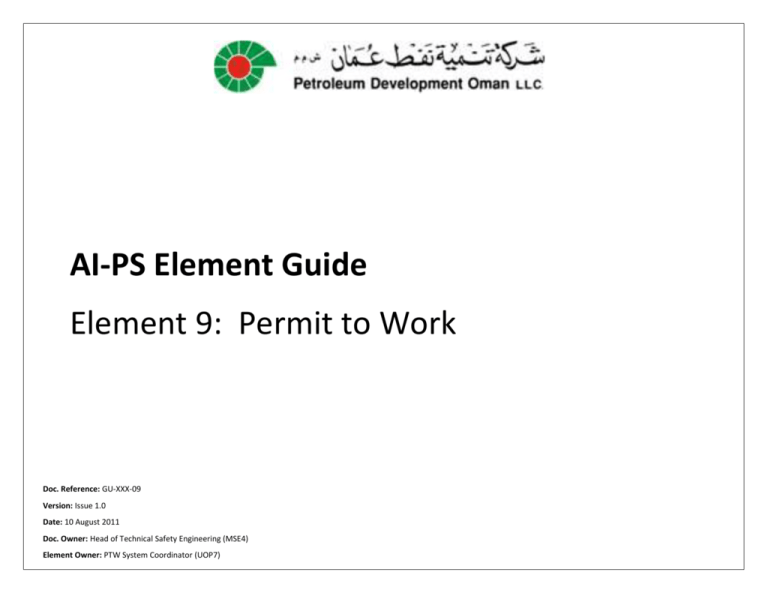
AI-PS Element Guide Element 9: Permit to Work Doc. Reference: GU-XXX-09 Version: Issue 1.0 Date: 10 August 2011 Doc. Owner: Head of Technical Safety Engineering (MSE4) Element Owner: PTW System Coordinator (UOP7) AI-PS Element Background There are 20 elements in total within the PDO AI-PS Management System as follows: AI-PS in PDO Elements list: Assuring the safety of our people, our assets, the environment and the company’s reputation is a core value of PDO and providing assurance that we are managing our major process safety risks is a critical aspect of our corporate governance. Asset Integrity Process Safety (AI-PS) describes the way we manage our assets so that the process risk is As Low As Reasonably Practicable (ALARP). What it is Asset Integrity Process Safety (AI-PS) is the means of ensuring that the people, systems, processes and resources, which deliver integrity, are in place, in use and fit for purpose throughout the whole lifecycle of the asset. The aim is to be able to confidently state that ‘our assets are safe and we know it’. Asset Integrity Process Safety Management is a complex area of expertise covering a wide range of components, all of which are essential to ensuring systems, processes and equipment perform as required. There are a number of Elements which make up the Asset Integrity Process Safety management system. Structure of AI-PS Assurance in PDO PDO has a three-tiered approach to AI-PS assurance: Level 1: Includes audits conducted on behalf of PDO's Internal Audit Committee (IAC) as part of the Integrated Audit Plan. This includes independent audits carried out by external bodies, such as Shell. Level 2: Includes audits carried out on behalf of Asset Managers as part of their own Asset level assurance processes. Level 3: Includes task verification and assurance activities that supplement the formal audit process. Element 1: Process Safety Culture Element 2: Compliance with Standards Element 3: Corporate Process Safety Competency Element 4: Workplace Involvement Element 5: Stakeholder Outreach Element 6: Process Knowledge Management Element 7: HEMP Element 8: Plant Operating Manuals Element 9: PTW Element 10: Technical Integrity Element 11: Contractor Management Element 12: Training and Performance Assurance Element 13: Management of Change Element 14: Readiness for Start Up Element 15: Conduct of Operations Element 16: Emergency Management Element 17: Incident Management Element 18: Measurements and Metrics Element 19: Audit and Verification of Level 2 Process Element 20: Management Review and Continuous Improvement Element 9: PTW Background to Element A permit-to-work (PTW) system is an integral part of a safe system of work and can help to properly manage the wide range of activities which can take place within a process plant or storage facility. Permit-to-work systems form an essential part of the task risk assessment process. When a task is identified an appraisal should be carried out to identify the nature of the task and its associated hazards. Next, the risks associated with the task should be identified together with the necessary controls and precautions to mitigate the risks. The extent of the controls required will depend on the level of risk associated with the task and may include the need for a permit-to-work. Aims and Objectives of Element A permit-to-work system is a formal recorded process used to control work which is identified as potentially hazardous. It is also a means of communication between site/installation management, plant supervisors and operators and those who carry out the hazardous work. The objectives of the PTW system are: To ensure that no work is carried out on site unless given the proper authority; To ensure that the person in charge of operations within the concession area/plant is aware of all work being carried out; To ensure that the person(s) doing the work fully understand the exact identity, nature and extent of the work, the potential hazards involved, the precautions to be taken and any limitations regarding the extent and duration of the work; To provide a system of control and to provide a record showing that the nature of the work and precautions required have been checked by appropriately authorised persons; To provide a formal hand-back of assets so that the equipment affected by the work is in a safe condition and ready for re-commissioning; To comply with the legal framework of Oman – it is a legal document. Scope of Element The scope of this element applies to all PDO operational sites to ensure that all work is carried out under a safe system of work. Requirements of Element To achieve a safe working environment by providing management control over various activities that may have potentially hazardous interactions. AI-PS Element Guide Implementation Aims and Objectives of AI-PS Element Guide The aim of this AI-PS Element Guide is to provide background to AIPS and a structured and consistent approach to carrying out Level 2 Self Assessments and Level 3 Verification for all AI-PS Elements within PDO. The intended audience for the guide are the members of the AIPSALT although this can be used as a basis for training and awareness for all staff at the asset. Responsibilities and Accountabilities for AI-PS Element Guide Implementation The Operations Manager is accountable for the Level 2 Assurance process at the asset. Completion of the Level 2 Self Assessment and Level 3 Verification Checklists, as provided in this element guide, is the responsibility of the Element Champions and AIPSALT. The Delivery Team Leader (DTL) is accountable for the AIPSALT. AI-PS Assurance Leadership Team (AIPSALT) The AIPSALT is comprised of the asset DTL and Process Safety Element Champions (PSEC). The DTL and PSEC roles include: reporting the status of the Level 3 Verification activities for the relevant Element at the AIPSALT meeting; maintaining Key Performance Indicators (KPIs) for the Element; monitoring the effectiveness of the Level 3 Verification activities in assuring AI-PS, and recommending changes to improve effectiveness and efficiency as appropriate; monitoring the progress of corrective actions and improvement plans associated with that Element; and leading Level 2 Self-Assessment of compliance with the requirements of that Element. Level 2 Assurance Level 2 Self Assessment and Audit Level 2 assurance is provided by a series of AI-PS audits carried out on behalf of Asset Directors and Operations Managers as part of their own Directorate-Level assurance processes. Level 2 Audits (and Level 2 Self Assessments) are conducted at each Directorate using standard protocols and templates described in this series of AI-PS Element Guides. The Level 2 Self Assessment Checklist (provided in this AI-PS Element Guide) can be viewed as a ‘health check’ of asset performance again the element. Completing the Level 2 Self Assessment will help the asset to identify areas for improvement ahead of the Level 2 Audit. Frequency of Level 2 Assurance Level 2 Audits are conducted annually at each Directorate but the frequency and duration may be adjusted to reflect either positive or negative trends, recent audit findings, emerging risks and alignment with other audit activities. The schedule of Level 2 audits is set in the Directorate HSE Plan. The frequency of Level 2 Self Assessment should also reflect how well the asset is performing against all AI-PS Elements and be performed no less than on an annual basis (ahead of the Level 2 Audit). Level 3 Verification Checklist Level 3 Verification Description Level 3 Verification demonstrates compliance with the asset HSE Case ‘barriers’, HSE Critical Tasks, operational procedures and other requirements defined in the HSE Management System. These activities provide an ongoing check that the procedures, tests and inspections necessary to maintaining the functionality of Safety Critical Elements and systems are completed as required so that process risk is managed to a level that is As Low As Reasonably Practicable (ALARP). In summary, the Level 3 Checklists are an operational level sample check or ‘mini audit’ completed by the asset against PDO and asset based procedures. The effectiveness of the Level 3 Verification process is assessed during the Level 2 Self Assessment process and ultimately via the Level 2 Audit programme. Verification Checklists Level 3 Verification checklists have been developed for each AI-PS Element within PDO in order to provide a structured and consistent approach to Level 3 Verification across all assets. The Level 3 Verification checklists are structured as a sample check or specific and localised audit of the Element in question. By successfully verifying that the Level 3 Verification activities are being completed correctly it provides a strong indication that the element is being implemented at the ’system level’ (assessed via the Level 2 Self Assessment and Level 2 Audits). The Level 2 Self Assessment and Level 3 Verification checklists for this element are provided below. Level 2 Self Assessment SN 9.1 9.2 9.3 9.4 9.5 Protocol Are PTW Level 3 assurance checks carried out in line with the Asset’s defined schedule? Are all necessary personnel trained to the appropriate level in the PTW system in accordance with PR-1172? Do the results of the Level 3 assurance PTW checks indicate an improving trend? Are the findings of the Level 3 assurance PTW checks used to generate improvement activities? Are actions identified from Level 3 assurance PTW checks and other Asset assurance activities tracked to completion by the AIPSALT, and completed in a timely manner? Y / N / NA & Evidence Possible approach Asset KPI reported to AIPSALT by Element Champion Element Champion check of Asset training matrix Asset KPI reported to AIPSALT by Element Champion Review of action tracking database by Element Champion Asset KPI reported to AIPSALT by Element Champion AI-PSM Level 3 PTW System Audit Form Worksite examination & Permit Holder - Interview Area _________________________________________________________________ Name ____________________________________________ Date ___________ Contractor / Ref. ID. ___________________ Permit Type _______________________________________ Yes 1) Check a) Is the Permit Holder at the Worksite, and licensed for the task? b) Is the activity clearly shown on the Permit Location Board at the Permit Issue Point? 2. Worksite Examination with Permit Holder a) Is a correctly completed and validated permit displayed on the worksite? Is it applicable for that specific worksite? b) Are the copies of any supplementary certificates, as identified on the Permit, attached, completed correctly and requirements being met? c) Are any lifting activities supported by an appropriately approved lifting plan in accordance with PR-1709? d) If the Permit is Class A or contains a hydrocarbon isolation, has it been countersigned by the Production Co-ordinator? e) Is the work area free of potentially conflicting activities or Process Safety Interfaces? f) If a vehicle or diesel engine is used, is it approved via the permit to be on site, and is the required level of gas monitoring in place? g) Is the Job HSE Plan attached, and has a quality TRIC discussion taken place? Check TRIC card. Have all the local specific hazards (working at height, chemicals etc.) been identified, and are any special precautions and controls in place and being observed? Have any changes to worksite hazards been re-assessed? h) Is the safety equipment used appropriate, in good condition and in the correct location? Are personnel briefed on its use? i) Is any temporary equipment in use at the worksite certified, and if remaining at the location is it in the station register in accordance with PR-1960? No Remarks Yes 3. No Remarks Permit Holder a) Has the PTW holder been briefed on the requirements of the permit and Job Safety Plan by the Permit Applicant? b) How was the Job HSE Plan explained to the work party? What special observations or precautions were discussed? c) Does the PTW holder have a copy of the PTW procedure PR-1172 with him at site? d) Has the Area Authority visited the worksite? e) Has a contractor supervisor visited the worksite? j) What recovery action has been identified in the event of worksite conditions changing adversely i.e. gas, weather, ground conditions etc.? k) Is the PTW Holder able to communicate effectively in English? Auditor overall comments Auditor Name________________ Signature _______________ Indicator ________________ Date _____________


